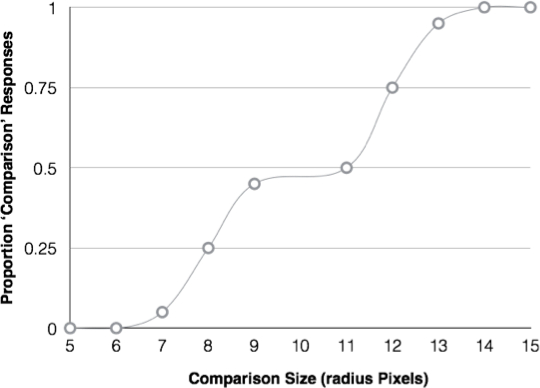Just-noticeable Differences
Source: Laboratory of Jonathan Flombaum—Johns Hopkins University
Psychophysics is a branch of psychology and neuroscience that tries to explain how physical quantities are translated into neural firing and mental representations of magnitude. One set of questions in this area pertains to just-noticeable differences (JND): How much does something need to change in order for the change to be perceivable? To pump intuitions about this, consider the fact that small children grow at an enormous rate, relatively speaking, but one rarely notices growth taking place on a daily basis. However, when the child returns from sleep-away camp or when a grandparent sees the child after a prolonged absence, just a few weeks of growing is more than perceptible. It can seem enormous! Changes in height are only noticed after an absence because the small changes that take place on a day-to-day basis are too small to be perceivable. But after an absence, many small changes add up. So how much growth needs to take place to be noticeable? The minimal amount is the JND.
Psychologists and neuroscientists measure JND in many domains. How much brighter does a light need to be to be noticed? How much louder does a sound need to be? They often obtain the measurements by employing a forced-choice paradigm. This video will focus on size, demonstrating a standard approach for measuring a JND when the area of a shape changes.
1. Equipment
- For this experiment, use a computer and experiment implementation software such as E-Prime, or a programming environment such as MATLAB or PsychoPy.
2. Stimuli and Experiment Design
- This experiment will involve repeated trials with the same basic design. Two discs will appear on the screen simultaneously, one on the left side and one on the right. One will always be bigger than other, and the task will be to use a keypress to select the larger one. T
The graph in Figure 3 shows the proportion of time in which the comparison stimulus was chosen as a function of the size of its radius. Recall that the constant stimulus always has a 10-px radius in this experiment. This is why with a radius of 5 or 6 px the comparison is almost never chosen, and it is almost always chosen with a radius if 14 or 15 px. However, with a radius of 9 or 11 px, the comparison is difficult. Participants often make mistakes. The JND is defined a
One of the main applications of the constant stimulus approach to measuring a JND has come in neuroscience, specifically in neurophysiology studies devised to investigate how the firing of individual neurons encodes physical properties about the world. These studies usually involve a monkey with electrodes implanted in their visual cortex. The electrodes penetrate individual cells that respond to visual stimulation by firing or spiking, that is, by conducting a rapid electrical signal. In studies on using JND methods, re
Skip to...
Videos from this collection:

Now Playing
Just-noticeable Differences
Sensation and Perception
15.3K Views

Color Afterimages
Sensation and Perception
11.0K Views

Finding Your Blind Spot and Perceptual Filling-in
Sensation and Perception
17.2K Views

Perspectives on Sensation and Perception
Sensation and Perception
11.7K Views

Motion-induced Blindness
Sensation and Perception
6.8K Views

The Rubber Hand Illusion
Sensation and Perception
18.1K Views

The Ames Room
Sensation and Perception
17.1K Views

Inattentional Blindness
Sensation and Perception
13.1K Views

Spatial Cueing
Sensation and Perception
14.8K Views

The Attentional Blink
Sensation and Perception
15.7K Views

Crowding
Sensation and Perception
5.7K Views

The Inverted-face Effect
Sensation and Perception
15.4K Views

The McGurk Effect
Sensation and Perception
15.9K Views

The Staircase Procedure for Finding a Perceptual Threshold
Sensation and Perception
24.2K Views

Object Substitution Masking
Sensation and Perception
6.4K Views
Copyright © 2025 MyJoVE Corporation. All rights reserved


